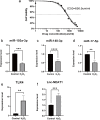Competing endogenous RNA network analysis of the molecular mechanisms of ischemic stroke
- PMID: 36755220
- PMCID: PMC9906963
- DOI: 10.1186/s12864-023-09163-1
Competing endogenous RNA network analysis of the molecular mechanisms of ischemic stroke
Abstract
Background: Ischemic stroke (IS) is a serious neurological disease that largely results in long-term disability and death. Extensive evidence has indicated that the activation of inflammation and ferroptosis significantly contribute to the development of IS pathology. However, the underlying molecular mechanism remains unclear. In this study, we aimed to identify potential biomarkers associated with IS through the construction of a competing endogenous RNA (ceRNA) network and to investigate the possible inflammatory and ferroptosis-related molecular mechanisms.
Results: We identified 178 differentially expressed target messenger RNAs (DETmRNAs) associated with IS. As revealed through enrichment analysis, the DEmRNAs were mainly enriched in the inflammatory signaling pathways and also related to ferroptosis mechanism. The CIBERSORT algorithm showed immune infiltration landscapes in which the naïve B cells, naïve T cells, and monocytes had statistically different numbers in the cerebral infarction group compared with the control group. A ceRNA network was constructed in this study involving 44 long non-coding RNAs (lncRNAs), 15 microRNAs (miRNAs), and 160 messenger RNAs (mRNAs). We used the receiver operating characteristic (ROC) analysis to identify three miRNAs (miR-103a-3p, miR-140-3p, and miR-17-5p), one mRNA (TLR4), and one lncRNA (NEAT1) as the potential key biomarkers of the ceRNA network. The key mRNA and lncRNA were shown to be highly related to the ferroptosis mechanism of IS. The expression of these key biomarkers was also further validated by a method of quantitative real-time polymerase chain reaction in SH-SY5Y cells, and the validated results were consistent with the findings predicted by bioinformatics.
Conclusion: Our results suggest that the ceRNA network may exert an important role in the inflammatory and ferroptosis molecular mechanisms of IS, providing new insight into therapeutic IS targets.
Keywords: Biomarker; Ferroptosis; Inflammatory response; Ischemic stroke; Network analysis.
© 2023. The Author(s).
Conflict of interest statement
The authors declare no competing interests.
Figures










Similar articles
-
Construction of an lncRNA-mediated ceRNA network to investigate the inflammatory regulatory mechanisms of ischemic stroke.PLoS One. 2025 Jan 23;20(1):e0317710. doi: 10.1371/journal.pone.0317710. eCollection 2025. PLoS One. 2025. PMID: 39847586 Free PMC article.
-
Comprehensive analysis of differentially expressed profiles of lncRNAs, mRNAs, and miRNAs in laryngeal squamous cell carcinoma in order to construct a ceRNA network and identify potential biomarkers.J Cell Biochem. 2019 Oct;120(10):17963-17974. doi: 10.1002/jcb.29063. Epub 2019 May 24. J Cell Biochem. 2019. PMID: 31127661
-
Bioinformatics Analysis of the Mechanisms of Diabetic Nephropathy via Novel Biomarkers and Competing Endogenous RNA Network.Front Endocrinol (Lausanne). 2022 Jul 14;13:934022. doi: 10.3389/fendo.2022.934022. eCollection 2022. Front Endocrinol (Lausanne). 2022. PMID: 35909518 Free PMC article.
-
Reconstruction and Analysis of the Differentially Expressed IncRNA-miRNA-mRNA Network Based on Competitive Endogenous RNA in Hepatocellular Carcinoma.Crit Rev Eukaryot Gene Expr. 2019;29(6):539-549. doi: 10.1615/CritRevEukaryotGeneExpr.2019028740. Crit Rev Eukaryot Gene Expr. 2019. PMID: 32422009 Review.
-
The Mechanisms of Long Non-coding RNA-XIST in Ischemic Stroke: Insights into Functional Roles and Therapeutic Potential.Mol Neurobiol. 2024 May;61(5):2745-2753. doi: 10.1007/s12035-023-03740-x. Epub 2023 Nov 6. Mol Neurobiol. 2024. PMID: 37932544 Review.
Cited by
-
Integration Analysis of miRNA Circulating Expression Following Cerebellar Transcranial Direct Current Stimulation in Patients with Ischemic Stroke.Biochem Genet. 2024 Sep 21. doi: 10.1007/s10528-024-10912-4. Online ahead of print. Biochem Genet. 2024. PMID: 39304639
-
Knockdown of NEAT1 prevents post-stroke lipid droplet agglomeration in microglia by regulating autophagy.Cell Mol Life Sci. 2024 Jan 12;81(1):30. doi: 10.1007/s00018-023-05045-7. Cell Mol Life Sci. 2024. PMID: 38212456 Free PMC article.
-
Multicenter Validation of lncRNA and Target mRNA Diagnostic and Prognostic Biomarkers of Acute Ischemic Stroke From Peripheral Blood Leukocytes.J Am Heart Assoc. 2024 Jul 16;13(14):e034764. doi: 10.1161/JAHA.124.034764. Epub 2024 Jul 9. J Am Heart Assoc. 2024. PMID: 38979813 Free PMC article.
-
MiR-122 overexpression alleviates oxygen-glucose deprivation-induced neuronal injury by targeting sPLA2-IIA.Front Neurol. 2024 May 10;15:1395833. doi: 10.3389/fneur.2024.1395833. eCollection 2024. Front Neurol. 2024. PMID: 38798705 Free PMC article.
References
-
- Pu L, Wang M, Li K, et al. Identification micro-RNAs functional modules and genes of ischemic stroke based on weighted gene co-expression network analysis (WGCNA)[J] Genomics. 2020;112(4):2748–2754. - PubMed
-
- Ding Q, Liu S, Yao Y, et al. Global, regional, and National Burden of ischemic stroke, 1990-2019[J] Neurology. 2022;98(3):e279–e290. - PubMed
MeSH terms
Substances
LinkOut - more resources
Full Text Sources
Other Literature Sources
Medical
Research Materials

